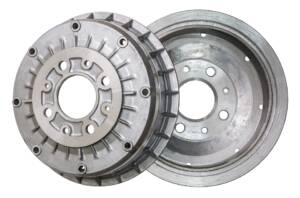Project Report For Brake Drums
Introduction
Project report for Brake Drums is as follows.
A brake drum is a cylindrical drum attached to the inside of a car’s wheel and thus rotates at the same rate as the wheel. The drum encircles a set of brake shoes coated in friction-generating materials. When the brake pedal is depressed, these shoes are pushed outwards against the inner surface of the brake drum, causing friction and thus slowing the vehicle. A brake drum is typically made of iron, which makes it resistant to wear. This results in the car having a ‘long pedal,’ because the driver must press it further down to achieve the same braking performance. Water ingress can also occur with drum brakes.

If water gets into the drum, it can become compressed between the brake shoe and the inside of the brake drum, increasing the time it takes for a vehicle to stop. Most rotating machines, including automobiles, require motion control via brakes. A drum brake is a type of brake that relies on friction generated by a set of shoes or pads that press and grip a rotating cylinder-shaped part known as a brake drum. Drum brakes are also used by lifting machines and other heavy earth-moving machines because they are very safe and secure in operation.
Get Completely Custom Bankable Project Report
Product & ITS Application Of Brake Drums
Drum brakes are commonly used to describe brakes in which shoes press against the inner surface of the drum. A clasp brake occurs when shoes press against the outside of the drum. Drum brakes are commonly used in automobiles to achieve compact and lightweight construction for speed control. To fit into wheel rim housing, brake drums are mostly made of cast iron. The backing plate, brake drum, shoe, wheel cylinder, and various springs and pins are all components of a drum brake.
Advantages Of Brake Drums
- less expensive to manufacture
- Because they are more corrosion resistant than discs, they require less maintenance.
- Because of the built-in self-energizing effect, less input force is required (such as hydraulic pressure).
- Wheel cylinders are less difficult to recondition than callipers.
- Minor weight savings, primarily due to the use of much smaller and lighter hydraulic cylinders rather than callipers.
Market potential Of Brake Drums
The global automotive brake system market was worth USD 45.60 billion in 2021, and it is expected to grow at a compound annual growth rate (CAGR) of 5.4% between 2022 and 2030.
Expenses

Product Cost Breakup

Reveneue Vs Expenses

Market Trend

Increased demand for passenger and commercial vehicles in countries such as India and China, the market for automotive brake systems is expected to grow significantly. Furthermore, factors such as the adoption of strict safety standards, the adoption of luxury automobiles, and the increased use of disc brakes in commercial vehicles are propelling the market growth. Furthermore, the lifespan of brake components is limited to a certain number of kilometers, which drives up the replacement market.
Furthermore, concerns about road traffic collisions and the increasing number of fatalities have prompted participants to implement robust safety systems. Because of the stringent safety rules imposed by regulatory organizations and governments, the automobile brake system market will continue to grow.
The National Highway Traffic Safety Administration (NHTSA), a division of the United States Department of Transportation, intends to make automatic emergency braking mandatory in vehicles beginning in 2022.The automotive brake system market is divided into two types: drum brakes and disc brakes.
The disc brake segment is expected to grow at a CAGR of 6.5% during the forecast period, with a market share of 60.46% in 2021. Disc brakes have become increasingly popular in recent years. The ability of disc brakes to work in inclement weather without overheating or fading has contributed to their popularity. Furthermore, its compatibility with other advanced systems is propelling the disc brake segment forward.

